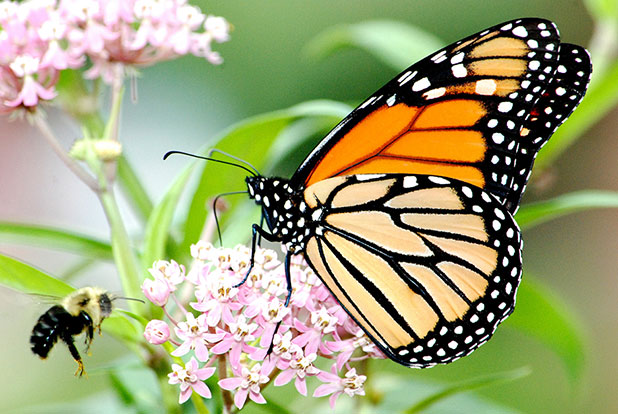Last week, PeerJ published “Density estimates of monarch butterflies overwintering in central Mexico”. This beautiful and iconic species (Danaus plexippus L.) is often featured in natural history documentaries as they have a fascinating migratory life cycle. In recent years there has been growing concern related to the ongoing decline of monarchs. In order to understand how best to conserve the species, this study used mathematical modelling to accurately estimate butterfly population densities which previously have varied widely. Wayne Thogmartin discusses the findings from his and his fellow authors’ paper and what implications this study has for monarch butterfly conservation efforts. 
PJ: Can you tell us a bit about yourself?
WT: I’m a quantitative ecologist with the United States Geological Survey, focusing most of my research effort on supporting the decisions the U.S. Fish and Wildlife Service, National Park Service, and other Department of Interior bureaus make when managing the natural resources and public lands of the United States.
PJ: Can you briefly explain the research you published in PeerJ?
WT: Monarch butterflies exhibit this incredible multi-generational migratory phenomenon, moving between breeding grounds in the United States and Canada and their wintering grounds in the high-elevation forests of central Mexico. This population has exhibited a multi-decadal decline. One of the concerns we face is trying to estimate how much habitat is available for this insect and how much is necessary to mitigate its risk of extinction. We’ve taken multiple tacts to address this question. This specific paper estimates the number of monarchs occurring in a hectare of habitat when the species is wintering in Mexico.

Monarch butterfly on swamp milkweed in Michigan. Photo by Jim Hudgins/USFWS
We synthesized multiple published estimates to obtain a best-estimate of the overwinter density of monarchs. Using this density estimate, we then calculated total population size and the total population size at a level agreed upon by the three nations, a goal that if achieved much reduces the risk of extinction of this species. Then, with this information at hand, we calculated how much milkweed is required to sustain this goal population. Monarch butterflies rely on milkweed exclusively for breeding and it is believed that long-term declines in milkweed availability are the cause of the species’ imperilment.
PJ: What kinds of lessons do you hope the public takes away from the research about Monarch Butterfly conservation?
WT: Monarch butterfly conservation is going to require a large effort among a broad constituency of interested parties. Returning monarchs to previous levels of abundance will require the participation of individuals across each of the three countries where monarchs occur, the U.S., Canada, and Mexico. It will also require participation across multiple sectors of society, from homeowners planting pollinator-friendly greenery in their yards to roadside authorities amending their mowing and spraying practices to increased farming precision by food producers which may allow marginal, unprofitable lands to be used for conservation.
PJ: How did you first hear about PeerJ, and what persuaded you to submit to us?
WT: I’ve known about PeerJ since its inception. I’ve been curious about its preprint server and its broad audience. Our work had originally been submitted to insect-related journals, but the editorial feedback we received was that the math-intensive nature of the work made it less suited to publication in an entomologically themed journal. However, PeerJ‘s broad audience should lead to some number of readers interested in the intersection of applied statistics to what is a troublesome conservation-related topic.
PJ: How would you describe your experience of our submission/review process?
WT: I thought the submission and review process was great. The submission process was painless. The review process was thorough, thoughtful, and very fair; our paper is much improved because of it.
PJ: Would you submit again, and would you recommend that your colleagues submit?
WT: Yes, I think I will. PeerJ makes the research freely available, easily accessible, and about as painless of a process for publishing as I’ve ever experienced.


